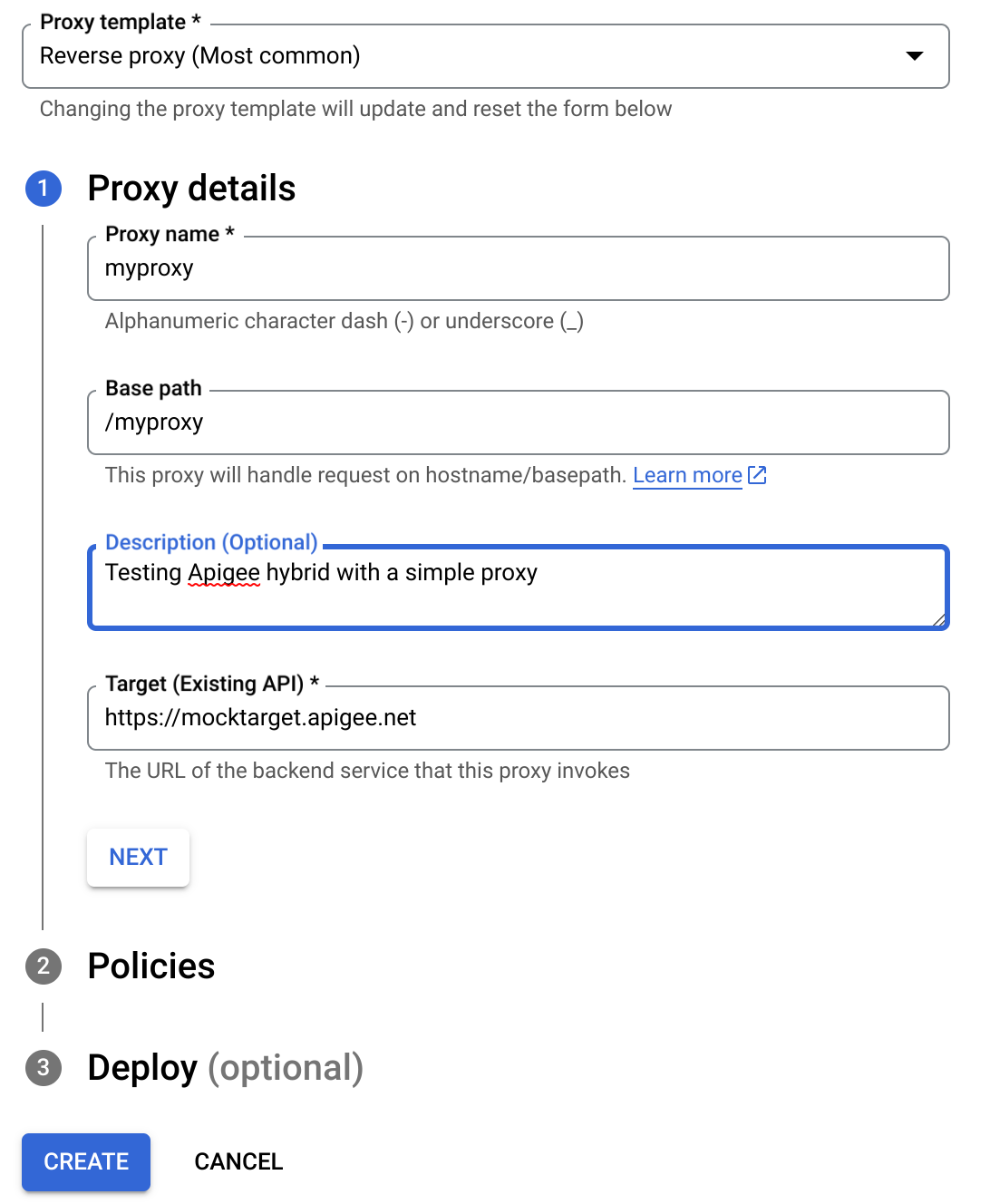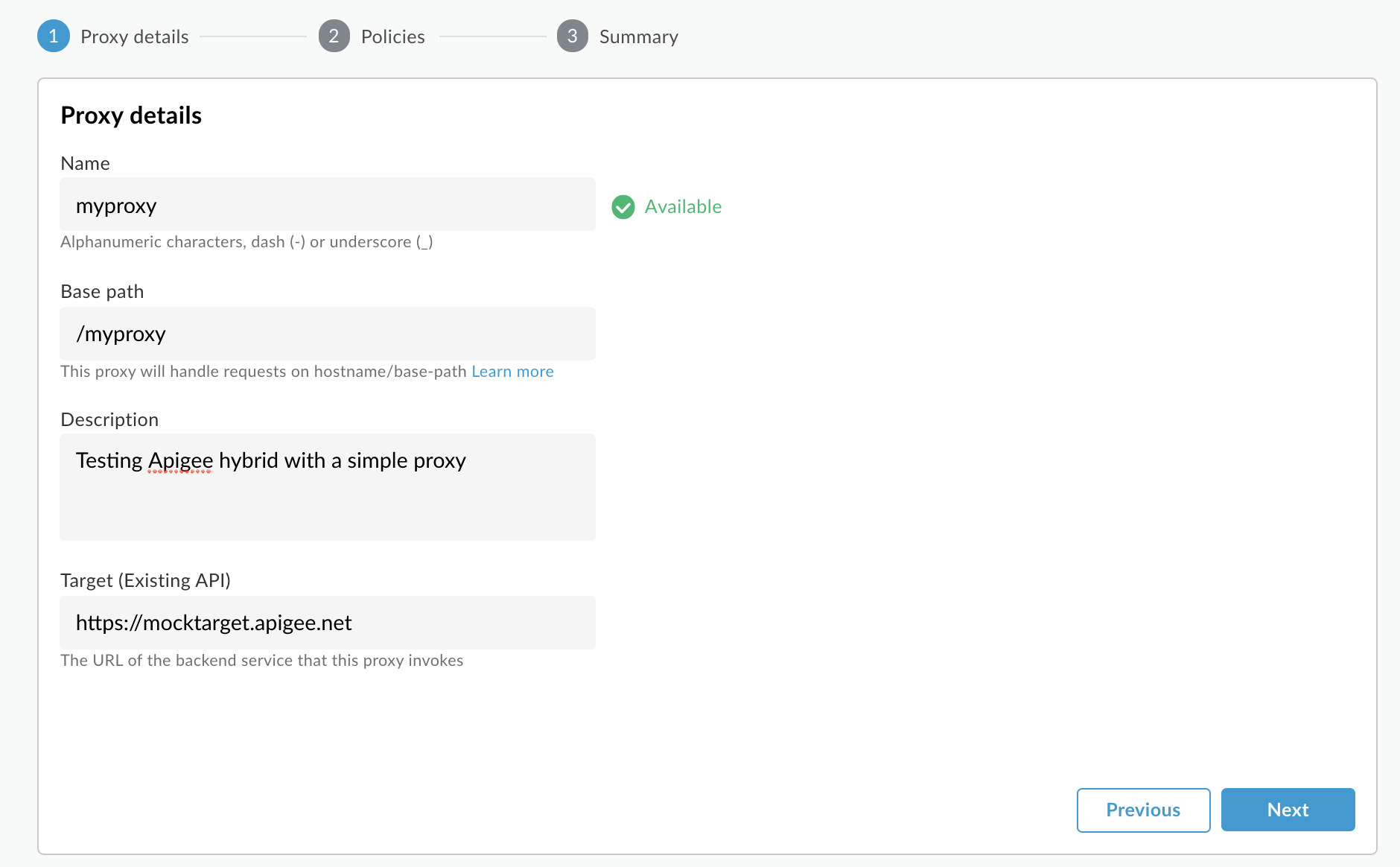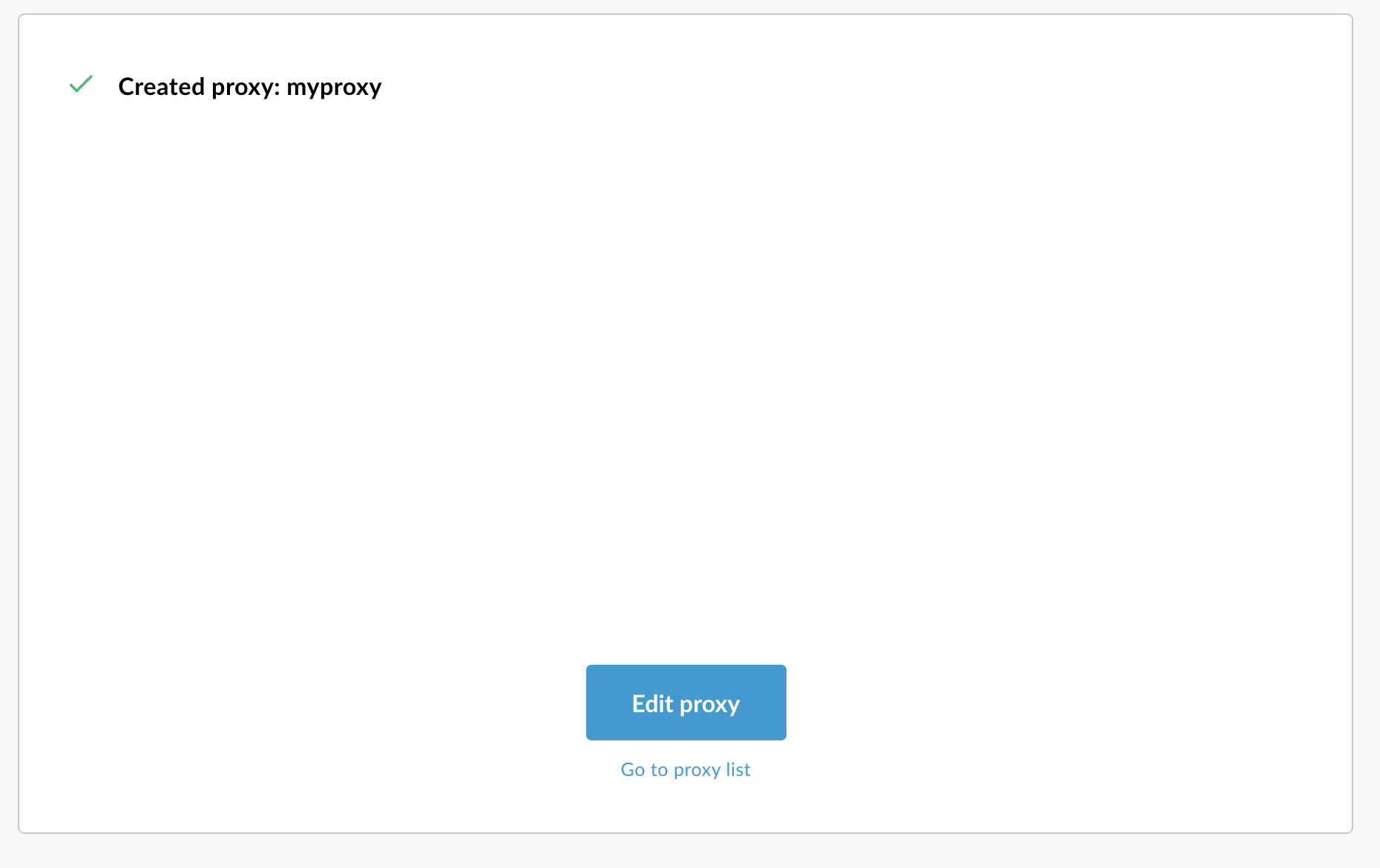Now that you've configured Google Cloud and the Apigee UI, and installed and configured the runtime, you're ready to see how it all works together.
1. Create a new API proxy using the Apigee UI
This section describes how to create a new API proxy in the UI by using the API Proxy Wizard.
Apigee in Cloud console
To create a new API proxy using Apigee in Cloud console:
- Open Apigee UI in Cloud console in a browser.
- Select your organization from the dropdown menu in the upper left corner.
- Select Proxy development > API proxies in the main view.
- Click Create.The API Proxy Wizard starts.
- Select Reverse proxy (most common).
The Proxy details view is displayed.
- Configure your proxy with the following settings:
- Proxy name: Enter myproxy. The remaining steps in this section assume that this is your proxy's ID.
- Base path: Automatically set to / followed by the proxy name, which in this example is /myproxy. The Base path is part of the URL used to make requests to your API. Edge uses the URL to match and route incoming requests to the proper API proxy.
- (Optional) Description: Enter a description for your new API proxy, such as "Testing Apigee hybrid with a simple proxy".
- Target (Existing API): Enter "https://mocktarget.apigee.net". This defines the target URL that Apigee invokes on a request to the API proxy. The mocktarget service is hosted at Apigee and returns simple data. It requires no API key or access token.
Your API proxy's details should look like the following:

- Click Next.
- On the Policies screen, select Pass through (no authorization) as the security option.
- Click Next.
- Under Deploy (optional), you have the option to select one or more environments in which to deploy your proxy, in the Deployment environments field. If you prefer not to deploy the proxy at this point, leave the Deployment environments field empty. You can always deploy the proxy later.
- Click Create. Apigee generates the proxy (sometimes referred to as the proxy bundle).
Apigee displays the Proxy summary view. If you chose to deploy the proxy, the Deployments section displays the Revision number, which is 1 when you first deploy. The Status column displays the environments in which the proxy is deployed with a green status indicator.
Below that, the Endpoints section displays:
- Proxy endpoints: The basepath you set for the proxy, which is this example
is
/myproxy. - Target endpoints: The basepath you set for the target, which in this
example is
https://mocktarget.apigee.net.
Classic Apigee
To create a new API proxy using Classic Apigee:
- Open Apigee UI in a browser.
- Select your organization from the dropdown menu in the upper left corner.
- Select Develop > API Proxies in the main view.
- Click Create New.The API Proxy Wizard starts.
- Select Reverse proxy (most common).
The Proxy details view is displayed.
- Configure your proxy with the following settings:
- Proxy Name: Enter "myproxy". The remaining steps in this section assume that this is your proxy's ID.
- Proxy Base Path: Automatically set to "/myproxy". The Proxy Base Path is part of the URL used to make requests to your API. Edge uses the URL to match and route incoming requests to the proper API proxy.
- (Optional) Description: Enter a description for your new API proxy, such as "Testing Apigee hybrid with a simple proxy".
- Target (Existing API): Enter "https://mocktarget.apigee.net". This defines the target URL that Apigee invokes on a request to the API proxy. The mocktarget service is hosted at Apigee and returns simple data. It requires no API key or access token.
Your API proxy's details should look like the following:

- Click Next.
- On the Policies screen, select Pass through (no authorization) as the security option.
- Click Next.
- On the Summary screen, select an environment to deploy your proxy to and
click Create and Deploy.
Hybrid generates the proxy (sometimes referred to as the proxy bundle):

- Click Go to proxy list.
Apigee displays the Proxies view, which displays a list of API proxies. Your new proxy should display with a green status indicator, meaning that it has been deployed.
2. Call the API proxy
When the UI indicates your proxy is deployed, you can try calling it using cURL or the REST client of your choice. For example:
- Make sure your
DOMAINenvironment variable is set to the domain name you used for the hostname for your environment group in Project and org setup - Step 3: Create an environment group.echo $DOMAIN
-
Find the external IP address and port of the Apigee ingress gateway with the following command:
kubectl get svc -n apigee -l app=apigee-ingressgateway
Your output should look something like:
NAME TYPE CLUSTER-IP EXTERNAL-IP PORT(S) AGE apigee-ingressgateway-prod-hybrid-37a39bd LoadBalancer 192.0.2.123 233.252.0.123 15021:32049/TCP,80:31624/TCP,443:30723/TCP 16h
- Export your external IP and port to variables:
export INGRESS_IP_ADDRESS=EXTERNAL_IP_ADDRESS
export INGRESS_PORT=PORT_NUMBER - Call the API proxy:
curl -H Host:$DOMAIN --resolve \ $DOMAIN:$INGRESS_PORT:$INGRESS_IP_ADDRESS \ https://$DOMAIN:$INGRESS_PORT/myproxy -k
For example:
curl -H Host:example.com --resolve example.com:443:233.252.0.123 https://example.com:443/myproxy -k
To learn more about building and deploying API proxies, see Build your first proxy overview.
